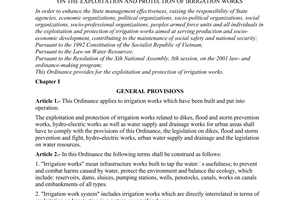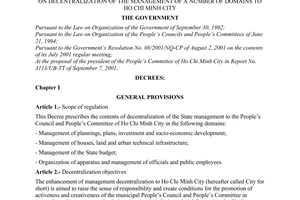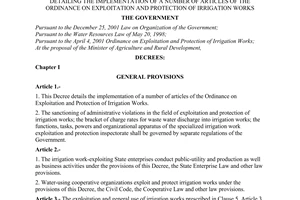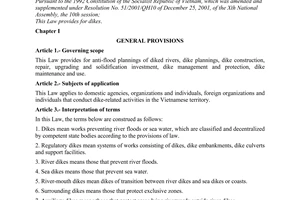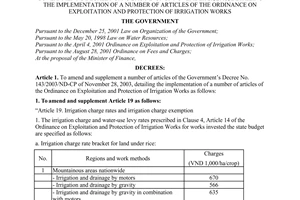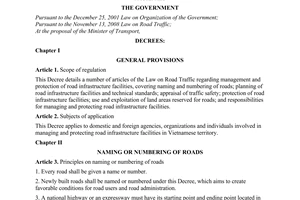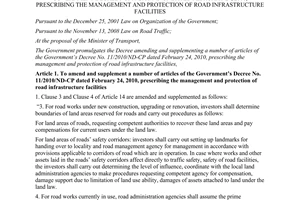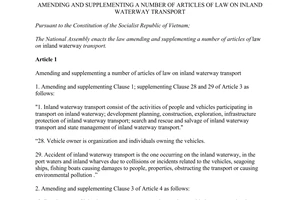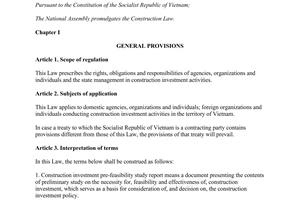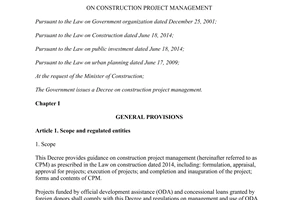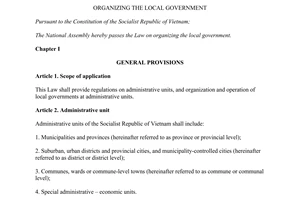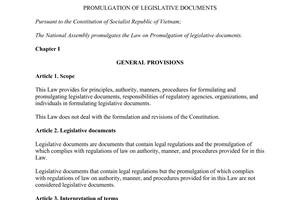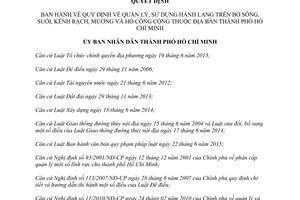Nội dung toàn văn Decision 22/2017/QD-UBND management and use of safety corridors at river Ho Chi Minh
|
THE PEOPLE’S
COMMITTEE OF HO CHI MINH CITY |
THE SOCIALIST
REPUBLIC OF VIETNAM |
|
No. 22/2017/QD-UBND |
Ho Chi Minh city, April 18, 2017 |
DECISION
ISSUING REGULATIONS ON MANAGEMENT AND USE OF SAFETY CORRIDORS AT RIVER, STREAM, CHANNEL, CANAL, TRENCH AND PUBLIC RESERVOIR BANKS WITHIN THE TERRITORY OF HO CHI MINH CITY
THE PEOPLE’S COMMITTEE OF HO CHI MINH CITY
Pursuant to the Law on Local Government Organization dated June 19, 2015;
Pursuant to the Law on Dikes dated November 29, 2006;
Pursuant to the Law on Water Resource dated June 21, 2012;
Pursuant to the Law on Land dated November 29, 2013;
Pursuant to the Law on Construction dated June 18, 2014;
Pursuant to the Law on Inland Waterway Traffic dated June 15, 2004 and the Law on Amendment to certain Articles of the Law on Inland Waterway Traffic dated June 17, 2014;
Pursuant to the Law on Issuance of Legislative Documents dated June 22, 2015;
Pursuant to the Government’s Decree No. 93/2001/ND-CP dated December 12, 2001 on delegating authority over certain sectors to Ho Chi Minh city;
Pursuant to the Government's Decree No. 113/2007/ND-CP dated June 28, 2007 specifying and guiding the implementation of a number of articles of the Law on Dikes;
Pursuant to the Government's Decree No. 11/2010/ND-CP dated February 24, 2010 on management and protection of road traffic infrastructure and the Government's Decree No. 100/2013/ND-CP dated October 20, 2013 on amendments to certain articles of the Decree No. 11/2010/ND-CP dated February 24, 2010;
Pursuant to the Government’s Decree No. 43/2014/ND-CP dated May 15, 2014 providing guidance on implementation of the Law on Land;
Pursuant to the Government’s Decree No. 59/2015/ND-CP dated June 18, 2015 on management of investment and construction projects;
Pursuant to the Government’s Decree No. 24/2015/ND-CP dated February 27, 2015 providing details and methods of implementation of certain articles of the Law on Inland Waterway Traffic and the Law on Amendment to certain Articles of the Law on Inland Waterway Traffic;
Pursuant to the Government’s Decree No. 43/2015/ND-CP dated May 6, 2015 providing for building and management of water resource corridors;
Pursuant to the Circular No. 15/2016/TT-BGTVT dated June 30, 2016 of the Ministry of Transport on management of inland waterway;
After considering the request of the Director of the Department of Transport made through the Statement No. 977/TTr-SGTVT dated March 2, 2017; opinions of the Department of Planning and Architecture (the Official Dispatch No. 263/SQHKT-HTKT dated January 16, 2017), the Department of Justice (the Official Dispatch No. 5659/STP-VB dated July 11, 2016 and the Official Dispatch No. 7892/STP-VB dated September 27, 2016) and the city’s Fatherland Front Committee (the Official Dispatch No. 172/MTTQ-BTT dated February 21, 2017),
HEREBY DECIDES
Article 1. Regulations on management and use of safety corridors at river, stream, channel, canal, trench and public reservoir banks within the territory of Ho Chi Minh city are hereto attached.
Article 2. This Decision shall enter into force from April 28, 2017 and replace the Decision No. 150/2004/QD-UB dated June 9, 2004 of the city’s People’s Committee.
Article 3. The Chief of the Office of the city’s People’s Committee, Directors of the city’s Departments, divisions and subdivisions, Head of City Development Research Institute, Vietnam Inland Waterway Administration, Vietnam Maritime Administration, Chairs of People’s Committees of urban/rural districts, wards/communes, towns, and Heads of entities and individuals concerned, shall be responsible for implementing this Decision./.
|
|
FOR THE
PEOPLE’S COMMITTEE |
REGULATIONS
ON MANAGEMENT AND
USE OF SAFETY CORRIDORS AT RIVER, STREAM, CHANNEL, CANAL, TRENCH AND PUBLIC
RESERVOIR BANKS WITHIN THE TERRITORY OF HO CHI MINH CITY
(Issued together with the Decision No. 22/2017/QD-UBND dated April 18, 2017
of the People’s Committee of Ho Chi Minh city)
Chapter I
GENERAL PROVISIONS
Article 1. Scope
1. Regulations on onshore safety corridors shall be applied to:
a) Municipal waterway traffic corridors over which engineering administration has been decentralized under the Decision of the city’s People’s Committee on approval of the Planning for development of water route and terminal networks within the territory of Ho Chi Minh city.
b) National inland waterway and maritime corridors over which authority is delegated to the Vietnam Inland Waterway Administration and Vietnam Maritime Administration.
c) River, channel, canal and trench traffic corridors which are subject to the general planning for water drainage to be implemented in Ho Chi Minh city.
d) Traffic corridors of rivers, channels, canals, trenches and public reservoirs intended for water drainage which:
- belong in the list of rivers, channels and canals which is published by the People’s Committee of Ho Chi Minh city.
- are subject to the detailed planning for water drainage which is approved by a relevant regulatory authority.
- are water-retainable ones according to the 1/2000 zoning plan which is approved by a relevant regulatory authority.
e) Public stream and reservoir corridors.
2. Regulations on onshore safety corridors shall be inapplicable to:
a) River, stream, channel or canal routes (or segments) which have been completely built or renovated (e.g. building roads, tree parks, embankments and other engineering infrastructure) according to the current planning.
b) Trenches which are not included in the regional detailed planning for water drainage approved by a relevant regulatory authority.
c) Trenches intended for water drainage which are included in the list of rivers, channels and canals published by the People’s Committee of Ho Chi Minh city.
d) Water non-retainable canals, subject to the 1/2000 zoning plan which is approved by a relevant regulatory authority.
e) Canals or trenches which are earthfilled and replaced by other water drainage systems as permitted with reference to investment projects approved by relevant regulatory authorities.
g) Channels or canals intended for agricultural irrigation purposes.
h) Rivers, channels or canals located within agricultural production land areas, forestry plantations, protection forests and ecological forests.
3. Dikes or water resource facilities shall be governed by the 2006 Law on Dikes; the Government’s Decree No. 113/2007/ND-CP dated June 28, 2007 providing details and guidelines for implementation of certain articles of the Law on Dikes; the Ordinance on Operation and Protection of Water Resource Facilities No. 32/2001/PL-UBTVQH10 dated April 4, 2001; the Government’s Decree No. 143/2003/ND-CP dated November 28, 2003 specifying implementation of certain articles of the Ordinance on Operation and Protection of Water Resource Facilities; the Decree No. 115/2008/ND-CP dated November 14, 2008 on modification and supplementation of certain articles of the Decree No. 143/2003/ND-CP dated November 28, 2003.
Article 2. Subjects of application
These Regulations shall be applied to entities, organizations or individuals performing one of the following activities:
- Management, construction, operation and utilization of facilities located within the precinct of onshore safety corridors.
- Management, construction, operation and utilization of river, stream, channel, canal, trench and public reservoir embankments.
- Management, construction, operation and utilization of sea ports, inland waterway ports or terminals.
- Dredging of navigable channels.
- Narrowing, widening or channelization of water flow of rivers, streams, channels, canals and trenches.
Article 3. Definition
1. Channel refers to a facility that carries water for irrigation, domestic and industrial uses, in addition to which its bank and course are used for both water and land transport purposes, including channels lined with earth, boulders, rocks, bricks, concrete, concrete reinforced by steel bars or metal wire mesh or other materials.
2. Canal refers to a passage used for carriage of water from a river to arable fields and movement of boats and ships.
3. Trench refers to a water-carrying facility whose cross section is small and which is intended for water resource uses (e.g. agricultural, silvicultural and aquacultural irrigation), transportation and drainage purposes.
4. Public reservoir refers to a lake designed for controlling flow of water that belongs to the city's drainage system (including natural and artificial reservoirs), or a water-controlling lake defined in the detailed planning for water drainage which is approved by a regulatory authority.
5. Onshore safety corridor refers to width of two land strips alongside a river, stream, channel, canal, trench and public reservoir which is measured from the planned embankment edge to the outermost shoreward point.
6. Natural embankment edge refers to an intersection where the natural slope at the bank of river, stream, channel, canal, trench or public reservoir meets the natural ground level in the horizontal direction.
7. Artificial embankment edge refers to the highest line of embankment that protects the bank of river, stream, channel, canal and public reservoir, which is approved by a regulatory authority.
8. Planned embankment edge refers to a lateral raised boundary defined by a regulatory authority.
9. Road safety corridor refers to either of lateral land strips at two sides of a road that ensures traffic safety and guards road facilities.
10. Classification level of river, channel or canal refers to the inland waterway classification made known to the public by a regulatory authority.
11. Water boundary line refers to the borderline that separates the inside land area from the safety corridor built at the bank of river, stream, channel, canal and public reservoir.
12. Navigable channel safety corridor refers to the limit of body of water or lateral strips of land at two sides of a navigable channel which is used for installing signs, protecting that navigable channel and providing traffic safety.
13. Temporary embankment refers to an embankment of which the highest line runs abreast of an existing shore line and which is built in the following forms, e.g. those ones that reinforce river banks by cajuput, coconut stakes, sandbags, rock gabions or boulder linings.
14. Rigid embankment is composed of the following structures:
- Vertical wall embankment that uses reinforced concrete boards as its retaining walls, and reinforced concrete wall corners placed on reinforced concrete base poles.
- Slope embankment that is made from rocks, is paved with interlocking concrete blocks or interweaving reinforced concrete resting on the base foundation strengthened by reinforced concrete or cajuput piles or columns.
15. Inland waterway terminal refers to an independent small-scale structure, including land areas and body of water ahead of a terminal, where inland watercraft anchors, loads or unloads goods, picks up or drops off passengers and renders other auxiliary services. It encompasses goods, passenger stations, general terminals, river-crossing terminal and purpose-built terminals.
16. Inland port refers to a system of facilities where inland watercraft, sea-going vessels and foreign watercraft anchor, load or unload goods, pick up or drop off passengers and render other auxiliary services; an inland harbor having its land area and body of water. It encompasses general, goods, passenger and purpose-built ports.
17. Entry into force of the Decision No. 150/2004/QD-UB dated June 9, 2004 refers to the 24th day of June of 2004 on which the Decision No. 150/2004/QD-UB dated June 9, 2004 takes effect.
Article 4. Principles of management of onshore safety corridors
1. All organizations and individuals may be vested with the legitimate right to use land within the precinct of onshore safety corridors and entitled to participate in investment and construction projects in conformity with the purposes set out in paragraph 3 Article 5 hereof and the detailed planning approved by relevant regulatory authorities.
2. Any encroachment upon, illegal appropriation or misuse of land in contrast to the purposes approved by regulatory authorities, or any act resulting in adverse effects, corrosion, or threatening safety and normal operational condition of construction works that protect river, stream, channel, canal, trench and public reservoir banks, shall be strictly prohibited.
3. The current natural state of river, stream, channel, canal, trench and public reservoir banks should be respected and conserved.
4. Depending on practical conditions of specific planned regions, competent state authorities shall be accorded the discretionary power to decide whether organizations or individuals are allowed to enter into a fixed-term contract to rent land located within the precinct of onshore safety corridors for the purposes set out in paragraph 3 Article 5 hereof, and shall maintain necessary elements for protection of these aforesaid banks and surrounding landscapes.
Chapter II
RULES AND PRINCIPLES FOR DETERMINATION AND USE OF ONSHORE SAFETY CORRIDORS
Article 5. Scope and principles of determination and use of onshore safety corridors
1. Bases for determination of onshore safety corridors
- As for rivers, streams, channels, canals, trenches and public reservoirs whose embankment edges are determined, the basis for determination of an onshore safety corridor shall be the planned embankment edge decided by the Department of Transport.
- As for rivers, streams, channels, canals, trenches and public reservoirs whose embankment edges have not been determined yet, the basis for determination of an onshore safety corridor shall be the boundary line defined by the VN 2000 coordinates-based digital cadastral map of Ho Chi Minh city which is provided and released by the Department of Natural Resources and Environment.
2. Scope of onshore safety corridors
|
No. |
Classification of river, stream, channel and canal |
Width of onshore safety corridor (m) (measured from the embankment edge to the shoreward point) |
|
1 |
Special class, class I, class II defined by the inland waterway and maritime engineering classification |
50m/ each side |
|
2 |
Class III, class IV defined by the inland waterway engineering classification |
30m/ each side |
|
3 |
Class III, class IV defined by the inland waterway engineering classification |
20m/ each side |
|
4 |
Water drainage rivers, channels, canals and trenches which belong in the list adopted by relevant regulatory authorities; are subject to the detailed planning for water drainage which is approved by relevant regulatory authorities, or are water-retainable ones defined by the 1/2000-scale zoning plan that is approved by relevant regulatory authorities. |
|
|
- Greater than 15m in width |
10m/ each side |
|
|
- 5m - 15m in width |
7m/ each side |
|
|
- Less than 5m in width |
5m/ each side |
|
|
- Less than 5m in width and protected by protection embankments |
3m/ each side |
|
|
5 |
Public reservoirs and streams |
10m |
As regards rivers, channels and canals where solutions to building protection embankments are available, depending on actual conditions, adjustment to width of onshore safety corridors may be considered to make effective use of unoccupied land running alongside their banks. In this case, People's Committees of urban/rural districts shall, based on approved planning schemes (urban, industrial or sectoral planning, etc.), conduct or collaborate with the Department of Transport and the Department of Planning – Architecture in research on and proposal for plans to adjust width of onshore safety corridors which will be then submitted to the People's Committee of the City to seek its approval decision.
3. Principles for use of onshore safety corridors
Within the precinct of onshore safety corridors, public utilities facilities may be built alongside rivers, streams, canals, trenches and public reservoirs provided that they harmonize with architectural landscapes, ensure national defence and maintain stability for banks and environment of rivers, channels or canals, including:
3.1 Engineering and social infrastructure group
a) Roads, water supply systems, water drainage systems, wastewater treatment systems, electricity systems, communications systems and public lighting systems.
b) Anti-corrosion works, water resource facilities, inland ports, inland terminals, inland waterway, terminal and water resource control centers.
c) Parks, landscaping plants, sports and gymnastic centers to which access is free for all residents.
d) Installation of maritime signs or signals and those for inland waterway, electricity, water and communications facilities.
e) Control centers, passenger waiting facilities, public toilets, parking lots for inland waterway public and tourist transport terminals that serve commercial purposes, have one story and are made from light materials (inland waterway terminals intended for internal and family uses shall not be permitted).
f) Warehouses and freight storage yards of inland ports and seaports which are defined by the predetermined planning or projects approved by the Ministry of Transport and People’s Committee of the City. (Note: Building warehouses at the distance of 20 m from the embankment edge to the shoreward point within the precinct of onshore safety corridor shall not be allowed).
h) Other specific works or structures, subject to the approval decision issued by the People’s Committee of the City on legal grounds.
3.2 Group of works and facilities intended for national defence and fire safety purposes.
3.3 Group of works and facilities intended for fixed-term services of which the maximum useful life is 3 years.
Owners of these works and facilities shall be required to dismantle them at their own expenses, shall not be allowed to claim compensation after end of their useful life or when the state withholds its land for construction of its own works or facilities.
a) Outdoor exhibition, entertainment and recreational centers, advertisement billboards and Vietnamese Tet flower markets.
b) Outdoor coffee shops, beverage bars and tourist agencies.
c) Sports and gymnastics areas.
As regards works or structures whose useful life is less than 30 days, People's Committees of urban/rural districts where they are located shall be accorded the discretionary power to grant their approval decision.
As regards works or structures whose useful life is 30 days or longer, People’s Committees of urban/rural districts where they are located shall preside over and collaborate with the Department of Transport and the Department of Planning – Architecture in review of them and submission of a request to the People's Committee of the City for grant of its approval decision.
3.4 Permission must be obtained from regulatory authorities before construction of works and structures on onshore safety corridors.
Article 6. Principles for determining onshore safety corridors under other circumstances
1. In the case where onshore safety corridors stated herein overlap protection corridors of roads, water resource facilities and dikes, extent of these corridors to be selected shall be the largest extent amongst the aforesaid corridors.
2. As for river, stream, channel and canal segments whose natural embankments are serpentine, uneven and fail to meet requirements concerning waterway, water drainage or road traffic alongside them in accordance with applicable technical standards, channelization of water flows may be permitted. The plan for channelization of water flows which is assessed, approved and implemented by the Department of Transport shall be deemed as the basis for application of regulations on onshore safety corridors set out in paragraph 2 Article 5 hereof.
3. As for river, stream, channel and canal segments affected by corrosion or aggradation leading to any change in the original state of embankment edges, the Department of Transport shall conduct surveys and assessments of changes in their banks and issue its decision on adjustment of embankment edges which align with actual ones.
4. Where any change in inland waterway engineering classification of rivers, channels or canals results in any change in the boundaries of onshore safety corridors, their extents shall be the same as those defined by lower engineering classifications. (Note: Special class is the highest inland waterway class while class VI is the lowest one).
Chapter III
INFORMATION PROVISION RESPONSIBILITY
Article 7. Responsibility for provision of information about planned embankment edges and onshore safety corridors
1. Organizations and individuals using land alongside rivers, streams, channels and canals shall be responsible for assisting in and facilitating surveying fieldwork activities carried out to determine embankment edges, drawing existing land use maps, installing markers indicating safety corridors of rivers, streams, channels, canals and public reservoirs for administrative purposes in conformity with the purposes defined in paragraph 3 Article 5 hereof.
2. The Department of Transport shall be responsible for providing information about planned embankment edges based on VN 2000 coordinate system and onshore safety corridors.
Article 8. Delegation of powers to regulatory authorities giving consent to location and size of embankments, works or structures built within the precinct of onshore safety corridors
1. The Department of Transport shall be accorded authority to give consent to location and size of embankments and works or structures built within the precinct of onshore safety corridors of rivers, channels, canals, trenches and public reservoirs intended for waterway traffic and water drainage purposes.
2. The Department of Agriculture and Rural Development shall be accorded authority to give consent to location and size of embankments and other works or structures built within the precinct of onshore safety corridors of rivers, channels, canals, trenches and public reservoirs intended for irrigation of land used for agricultural, aquacultural, forest development and salt production purposes.
3. People’s Committees of urban/rural districts:
- Give consent to location and size of temporary embankments and ensure that the highest point of embankment matches the embankment edge determined by the Department of Transport.
- Give consent to location and size of embankments and other works or structures alongside water drainage or irrigation trenches or canals intended for agricultural production purposes which are not in the list of rivers, channels and canals issued by the People's Committee of the City and are not subject to the detailed planning for water drainage approved by regulatory authorities.
Article 9. Conditions for approval of the detailed planning and grant of construction permit and land allocation
1. Upon assessment and approval of the detailed planning or processing of documentation for allocation of land and grant of land use right certificates and construction permits with respect to projects relating to provisions laid down in Article 2 hereof, the Department of Planning and Architecture, the Department of Natural Resources and Environment, and the Department of Construction, People’s Committees of urban/rural districts, shall be obliged to adopt planned embankment edges of rivers, streams, channels, canals, trenches and public reservoirs made known to the public by the Department of Transport, and onshore safety corridors defined by applicable regulations. Allocation of land located inside safety corridors of rivers, streams, channels, canals, trenches and public reservoirs shall be prohibited.
2. As regards urban embankments running along rivers, streams, channels, canals, trenches and public reservoirs, the Department of Construction shall be accorded authority to grant construction permits.
3. As regards suburban works or structures running rivers, streams, channels, canals, trenches and public reservoirs, construction permit exemption shall be granted under the following regulation: After receipt of the written consent from the Department of Transport to location and size of embankments, local construction authorities shall be authorized to carry out monitoring, examination and record keeping after obtaining the notification of the date of commencement of construction and construction design documents from project owners (according to paragraph 2 Article 89 of the Law on Construction No. 50/2014/QH13).
4. Construction permit exemption shall be granted with respect to temporary embankment projects.
Chapter IV
RESPONSIBILITIES OF ENTITIES CHARGED WITH MANAGEMENT AND USE OF ONSHORE SAFETY CORRIDORS
Article 10. Organization of management activities and authority delegation
1. The Department of Transport
a) Organize management activities and publish the list of rivers, streams, channels and canals intended for inland waterway and water drainage purposes under its administration on its website. Give consent to location and size of embankments alongside waterway traffic routes and planned urban water drainage lines within the territory of the City.
b) Inform planned embankment edges of rivers, streams, channels, canals and trenches intended for water drainage purposes within the city’s territory on the basis of the proposal prepared by the city’s Counterflooding Program Control Center.
c) Establish research plans and implement projects for engineering of dangerous river segments or those projects that mitigate corrosion caused by water current and ensure safety for waterway traffic. Organize activities to implement projects for construction of river bank protection embankments at regions exposed to high risks of corrosion.
d) Organize personnel performing regular inspection and assist People’s Committees of urban/rural districts in discovering and dealing with any violation or illegal encroachment upon rivers, streams, channels, canals, trenches and public reservoirs within the territory of the City. Direct the specialized inspection force to build a close cooperation with the construction inspection force at all levels to be determined to impose penalties for any illegal construction of facilities inside onshore safety corridors within its jurisdiction.
e) Collaborate with the Department of Planning – Architecture, People's Committees of urban/rural districts in preparation of the proposal for adjustment of width of onshore safety corridors with respect to specific river, stream, channel and canal routes or segments in response to actual conditions for submission to the People’s Committee of the City for its review and grant of its decision.
g) Preside over collaboration with departments – sectoral authorities in establishment of policies in which organizations and individuals are allowed to rent land inside onshore safety corridors to construct service areas within a fixed term to gain revenues paid to the City’s budget.
2. The City’s Counterflooding Program Control Center
Define planned embankment edges of channels and canals intended for water drainage purposes within the territory of the City and send a report on them to the Department of Transport for its review and release. Organize activities to install markers indicating extent of onshore safety corridors of channels and canals intended for water drainage purposes and authorize urban/rural districts' governments to manage them.
3. The Department of Agriculture and Rural Development
a) Organize management activities and publish the list of rivers, streams, channels, canals and public reservoirs under its jurisdiction on its website (except those put under management of the Department of Transport). The Department of Agriculture and Rural Development shall be accorded authority to give consent to location and size of embankments and other works or structures built within the precinct of onshore safety corridors of rivers, channels, canals, trenches and public reservoirs intended for irrigation of land used for agricultural, aquacultural, forest development and salt production purposes.
b) Determine and inform the extent of safety for protection corridors of water resource facilities and dikes under its jurisdiction; give consent to location and size of embankments of rivers, channels, canals, trenches and public reservoirs intended for irrigation of land used for agricultural, aquacultural, forest development and salt production purposes.
c) Preside over determination of the extent, inform and implement installation of markers indicating the boundary lines of water resource facilities and dikes on rivers, channels and canals intended for irrigation of land used for agricultural, aquacultural, forest development and salt production purposes within the City’s territory.
4. The Department of Natural Resources and Environment
a) On the basis of embankment edges informed by the Department of Transport, organize activities to determine markers on cadastral maps, carry out fieldwork installation of markers to determine onshore safety corridors of rivers, channels or canals intended for waterway traffic and authorize People's Committees of urban/rural districts to manage them. These markers shall be bases for imposition of penalties for illegal construction activities and encroachment upon rivers, channels and canals and within the precinct of onshore safety corridors.
b) Allocate land and award land use right certificates based on embankment edges informed by the Department of Transport and onshore safety corridors.
5. The Department of Planning – Architecture
Collaborate with the Department of Transport, People's Committees of urban/rural districts in preparation of the proposal for adjustment of width of onshore safety corridors with respect to specific river, stream, channel and canal routes or segments in response to actual conditions for submission to the People’s Committee of the City for its review and grant of its decision.
6. The Department of Construction
a) Instruct regulatory authorities to grant permits for construction, improvement and repair of facilities and houses within the precinct of onshore safety corridors in conformity with applicable regulations.
b) Grant construction permits to urban embankment projects.
c) Organize activities to inspect, supervise and impose strict penalties for earthfilling of and encroachment upon rivers, streams, channels, canals and public reservoirs; illegal and unregistered construction of houses and facilities inside onshore safety corridors under its regulated jurisdiction.
7. People’s Committees of urban/rural districts
a) Organize activities to administer onshore safety corridors in compliance with these Regulations. Direct People’s Committees of wards – communes and towns to administer onshore corridors and protect boundary markers indicating the extent of onshore safety corridors under their respective jurisdiction.
b) Carry out propaganda campaigns to raise public awareness of regulations on management and use of onshore safety corridors within the City’s territory and enhance state management of rivers, streams, channels, canals, trenches and public reservoirs and inland waterway safety within the territory of Ho Chi Minh city.
c) Give consent to location and size, and regularly conduct inspection of construction of temporary embankments within their jurisdiction to take timely action to mitigate corrosion of river, channel and canal banks.
d) Give consent to location and size of embankments and other works or structures alongside water drainage or irrigation trenches or canals intended for agricultural production purposes which are not in the list of rivers, channels and canals issued by the People's Committee of the City and are not subject to the detailed planning for water drainage approved by regulatory authorities.
e) Grant permits for construction and repair of houses under provisions laid down in paragraph 1 and 2 of Article 11 hereof.
g) Formulate plans and implement plans for urgent evacuation of residents from regions exposed to high risks of corrosion in order to avoid any danger to humans and damage or loss of property in case of emergencies.
h) Organize personnel undertaking inspection, detection and handling within their jurisdiction of any illegal encroachment upon rivers, streams, channels, canals, trenches and public reservoirs; illegal construction of works or facilities inside onshore safety corridors within their jurisdiction.
Article 11. Transition provisions
Embankment edges of rivers, streams, channels, canals, trenches and public reservoirs informed by regulatory authorities and boundaries of embankment edges approved by the Department of Transport for specific projects shall be deemed as bases for determination of the extent of onshore safety corridor.
1. As for residential land inside onshore safety corridors of family households or individuals of which origin and use dated back to earlier than June 24, 2004, residential land use right certificates and permits for construction of houses shall be granted to these family households and individuals to assure legitimate rights to real property.
In particular, if residential land existed before June 24, 2004, has not had any house (or any construction works), is located within onshore safety corridors but outside of the distance of 20m from the embankment edge to the shoreward point (with respect to rivers, channels and canals designated from class I to class IV), is not located within the extent of projects for urban beautification, relocation, resettlement or improvement of living conditions for inhabitants residing over and alongside channels or canals, People's Committees of urban/rural districts shall consider granting construction permits to provide homes for the population.
2. Houses existing over rivers, streams, channels, canals, trenches and public reservoirs or within the extent of onshore safety corridors before June 24, 2004.
a) With respect to houses over rivers, streams, channels, canals, trenches and public reservoirs (stilt houses), within the period during which the state does not demand relocation, they may remain unchanged and may be repaired or reinforced to maintain its original status (any change in size, dimension or structure of the previous houses shall be prohibited, except replacement of flooring boards, roofs or sidewalls made from light materials such as cemboard, wooden or corrugated iron sheets, etc.) to protect them from flooding and corrosion on condition that these activities do not cause any effect on water current and waterway traffic.
b) Houses located within the precinct of onshore safety corridors:
- As for those located within the extent of 20m of onshore safety corridor of class I – class VI rivers, channels and canals measured from the embankment edge to the shoreward point, and within the extent of onshore safety corridor of rivers, channels, canals and trenches intended for water drainage purposes as specified in No. 4 paragraph 2 Article 5 hereof, they may exist in the current state and may be repaired or renovated to recover size of previous houses (may change to corrugated iron, tile roofs; brick walls).
- As for those located within the extent of onshore safety corridor but outside of the space of 20m from the embankment edge to the shoreward point (with respect to class I – class IV rivers, channels and canals), they may be repaired or renovated to recover size of previous houses or may obtain permits for construction of new ones each of which has two stories (exclusive of mezzanines and staircase roofs) and is 12.2 m in height in comparison with the existing sidewalk level.
3. As for housing projects (located within onshore safety corridors) of which the 1/500-scale detailed planning scheme is approved before June 24, 2004:
a) As for those that are completely constructed according to construction permits or 1/500-scale detailed planning schemes or investment projects approved by regulatory authorities, are recognized by land use right certificates and have technical infrastructure facilities which are completely built, they may maintain their current state in which their location and size remain unchanged in accordance with aforesaid legal bases. Where site clearance or withholding of land is required for construction of other facilities by competent authorities, payment of compensation may be considered in accordance with regulations in force. As for unhoused land lots, modification of design of house to be built shall be subject to applicable regulations.
b) As for those that are developed according to construction permits or approved 1/500-scale detailed planning schemes or investment projects approved by regulatory authorities:
- As for those that are developed according to construction permits or 1/500-scale detailed planning schemes approved by regulatory authorities and within the construction progress specified in construction permits; or in the decision on approval of investment project; or in the written consent to investment project; or in documents submitted to apply for registration of approved investments of enterprises which are certified by People’s Committees of urban/rural districts, these projects may continue to be implemented on condition that the approved size is observed.
- As for those that are developed in violation of construction permits or 1/500-scale detailed planning schemes approved by regulatory authorities, or in violation of onshore safety corridors and within the implementation duration specified in construction permits; or in the decision on approval of investment project; or in the written consent to investment project; or in documents submitted to apply for registration of approved investments of enterprises which are certified by People’s Committees of urban/rural districts, the Department of Construction shall preside over and collaborate with the Department of Transport and People’s Committees of urban/rural districts in explicit review, enumeration and reporting of current state of projects or construction works and provision of proposed solutions to handle these violations and submission of requests to the City's People's Committee for its consideration and grant of its decision.
4. As for housing projects (located within onshore safety corridors) of which the 1/500-scale detailed planning scheme is approved after June 24, 2004:
They shall be implemented according to 1/500-scale detailed planning schemes approved by regulatory authorities on the basis of the planned embankment edge and onshore safety corridors informed by competent authorities. The Department of Construction shall be authorized to preside over and collaborate with the Department of Transport, the Department of Natural Resources and Environment, the Department of Planning – Architecture, and People’s Committees of urban/rural districts, in regularly promotion of inspection and imposition of penalties allowed by laws on any encroachment or illegal construction within the precinct of onshore safety corridors.
5. As for construction of embankments:
a) As for construction of embankments carried out before June 24, 2004, they may continue to exist for use as a way to ensure stability for river, channel and canal banks; prevent corrosion and protect facilities built alongside rivers, channels and canals.
b) As for construction of embankments carried out after June 24, 2004 to date, they may exist in the location and at the size approved by the Department of Transport or in alignment with the planned embankment edge, and may continue to be used as a way to ensure stability for river, channel and canal banks.
c) As for construction of embankments carried out after the entry into force of this Decision:
- Organizations and individuals may build rigid embankments to protect river, stream, channel, canal, trench and public reservoir banks on the basis of an agreement with the Department of Transport on the location and size of these embankments and subject to the Department of Construction’s permit for construction of these embankments in accordance with regulations in force.
- As for construction of embankments made from temporary materials (e.g. cajuput, coconut stakes, sand bags, boulder linings and rock gabions) which run close to existing river banks for the purposes of restriction and mitigation of river bank corrosion, People’s Committees of urban/rural districts shall agree on location and size of temporary embankments to be constructed by organizations and individuals./.
------------------------------------------------------------------------------------------------------
This translation is made by LawSoft and
for reference purposes only. Its copyright is owned by LawSoft
and protected under Clause 2, Article 14 of the Law on Intellectual Property.Your comments are always welcomed
